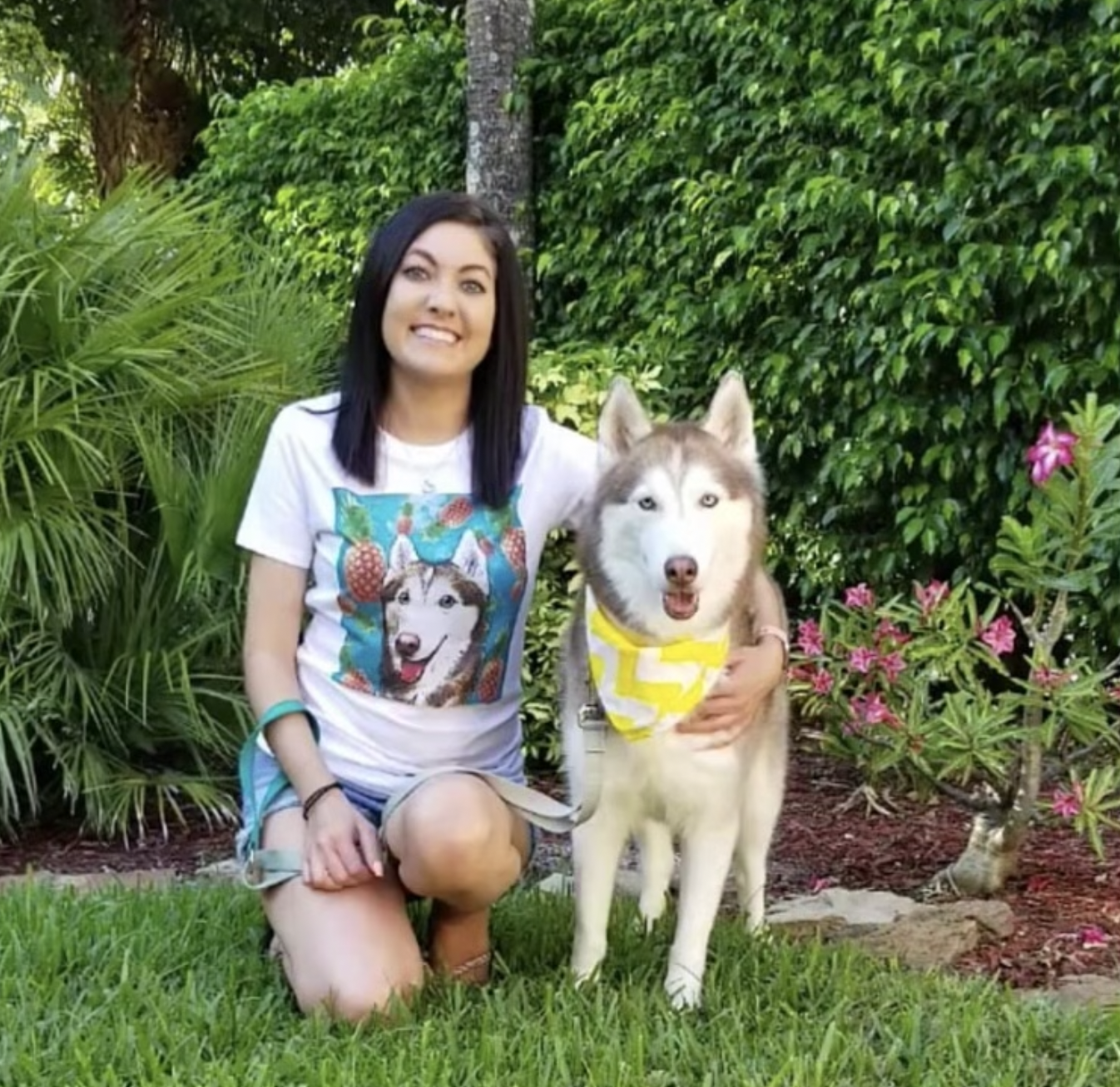As pet parents, we know we need to keep our dogs’ teeth healthy, but we also understand what a pain-in-the-fluffy-butt our pups can be when it comes to keeping their teefers clean. That’s why we’ve put together this list of tips to help you create a dental care routine that fights mouth gunk and garbage breath from multiple angles.
Why It’s Important To Keep Your Dog’s Teeth Clean


The number of innocent pups with bad teeth is too dang high! A staggering 80% of dogs have periodontal disease1 by age three! We’re not just talking about some leftover food-gunk on your pup’s teeth after forgetting to brush for a couple days. These dogs are already showing visible signs of gum disease, plaque buildup, tooth damage, and wretchedly funky breath before they’ve even reached adult dog years. Our pups deserve better!
A quick point of clarification: although true cavities are rare in dogs, the buildup of plaque and tartar (a combination of bacteria, organic matter, and minerals) on the tooth surface can induce severe inflammation and disease in the gums and bone surrounding the teeth. This in turn leads to a cycle of destruction, pain, and more inflammation that can kill/damage teeth and eat away at the jaw itself.
Related Article: 5 Ways Dental Disease Affects Your Dog’s Health
A consistent, daily dental routine can help improve and maintain the overall health and wellness of your best friend. Besides the very obvious garbage breath and yucky buildup on teeth, there are detrimental consequences that come from letting your dog’s oral health get out of control. Dental disease in dogs can lead to severe health problems, such as:
Bone Loss/Tooth Damage/Tooth Infection/Broken Jaw
It’s common sense that dental disease can lead to damage or loss of teeth. After all, humans are pretty familiar with what it’s like to get a painful cavity that requires a visit to the dentist. Unfortunately with dogs, dental problems often go unnoticed for far too long due to our pup’s limited vocabulary skills and pet parents not knowing the warning signs of early dental disease (scroll down to read about warning signs).
Advanced dental disease can lead to tooth infection that may require extraction of the tooth under general anesthesia at the vet office. In very bad cases, it can even lead to jaw bone loss! When an infected and damaged tooth goes untreated, the infection can eventually weaken your dog’s jaw so much that it breaks1. This is more common in small breed dogs, and is unnecessarily tragic.
Extraction is usually the only way to stop the spread of inflammation, infection, and jaw bone loss. If the tooth isn’t extracted, it may eventually fall out on its own once the bone surrounding it has been eaten away – there won’t be anything left to hold it in place.
Eye Infections, Oronasal Fistulas, and Sinus Infection
Tooth root abscesses are pockets of bacteria that start at the tooth root tip (embedded within the jaw at the point where the pulp of the tooth communicates with the rest of the body). Left untreated, these abscesses grow by destroying the surrounding jaw bone. If such an abscess occurs in the right (or wrong!) place, it can eat through the thin layer of bone separating the upper teeth from the sinus cavity, and create a communication between the infected tooth/mouth and the sinuses. This in and of itself can cause a sinus infection, chronic runny nose and sneezing, etc. But it can also impact the eyes with severe infections that sometimes lead to blindness1. This is more common in flat-faced breeds, like pugs.
Heart, Lung, and Liver Disease
Dental disease and inflammation cause gums to bleed more readily than usual. Infections in the jaw and gums also communicate with the blood flow of the jaw. Therefore, bacteria from an infected tooth can (and constantly do!) make their way into the bloodstream to circulate through the body. If your dog is unlucky, that bacteria may “land” in vital organs, like the heart, liver, and lungs. Once this bacteria reaches your dog’s heart, it can create colonies on the valves that pump blood throughout the body, which will eventually cause them to malfunction1.
The spread of bacteria to the lungs can lead to chronic respiratory disease and pneumonia1. Colonization of organs such as the liver or spleen can create abscesses or generalized inflammation that culminate in life-threatening emergencies or infections. In severe cases these issues can lead to death.
Kidney Disease And Urinary System Issues
Bacteria in the bloodstream from an infected tooth can also travel to the kidneys and bladder, which can lead to inflammation and tissue scarring1. This scarring makes it harder for the kidneys to filter out body waste through your dog’s pee, and makes it difficult for the kidneys to properly balance electrolytes such as sodium and potassium. At the same time, inflammation of the bladder can lead to urinary tract infections (UTIs). You may notice your dog becoming picky with their appetite or needing excessive potty breaks.
Diabetes
Any kind of chronic inflammation in the body causes some degree of insulin resistance. It’s not uncommon to see dogs with significant dental disease have difficulty with their diabetes regulation and insulin dosing1. If you’re struggling to maintain your dog’s blood glucose levels and notice that their teeth aren’t as healthy as they should be, talk to your veterinarian to create a plan to tackle their dental disease and better maintain their diabetes.
Related Article: 5 Ways Dental Disease Affects Your Dog’s Health
Warning Signs That Your Dog Has Periodontal Disease
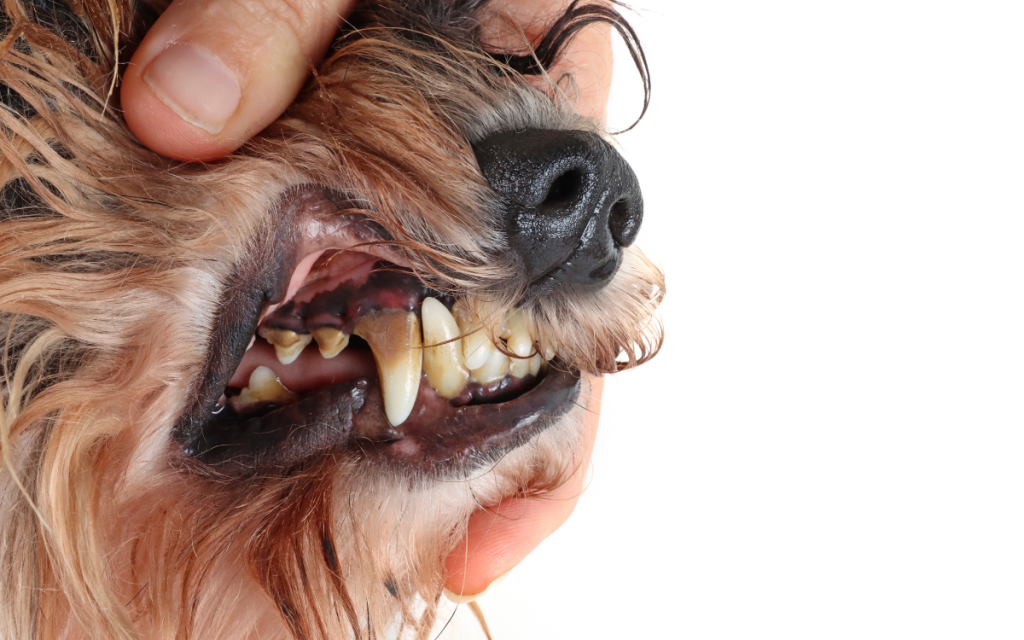

The first and most important thing to know is, periodontal disease can be invisible to the naked eye. You alone are not enough to completely monitor your dog’s dental health. There is not always gunk on the tooth surface, or an obvious pocket of inflammation to see when you open the mouth. The only way to truly know your dog’s dental health is with a veterinary anesthetized comprehensive oral health assessment that includes radiographs (x-rays) of the mouth. Many times, the disease is obvious only when you look beneath the surface…and it can already be quite severe.
As dental disease gets worse, the symptoms will generally become more noticeable than they were before (but again, don’t count on it). Once you see buildup on the teeth, your dog already has active periodontal disease. Although there is some home care you can do to take care of your pup’s teeth, these techniques are really primarily useful to prevent or slow the onset of periodontal disease in the first place – once it is started (again, once you see gunk on the teeth or notice chronically bad breath, you are already past the starting line) these at-home techniques really don’t accomplish much that matters.
A quick note to keep in mind: the buildup of tartar you see on the crowns of your dog’s teeth (the part of the tooth that lives above the surface of the gumline) is really mostly cosmetic – it doesn’t cause the big problems. It’s the buildup at and below the gumline that triggers the inflammation of the gums and jaw, which in turn causes the tooth damage, tooth infections, jaw bone loss, and gum recession. The under-the-gum buildup happens when plaque (invisible, soft white organic material including bacteria that builds up on dog (and our) teeth at the end of every day) is left undisturbed on the crown of the teeth and begins to spread to and below the gumline. By the time the invisible stuff has turned into the hard, brown/grey stuff you can easily see on the tooth surface, this spread has already happened and you have disease under the gumline.
So, once again, you really need a professional anesthetized cleaning to “remove” existing active periodontal inflammation. You need at-home care to keep it gone (or at least slow down its return).
Signs Of Periodontal Disease In Dogs
- Inflamed gums/gums bleeding after chewing bones or toys (also red blood spots on toys)
- Horribly funky breath that smells like a dumpster
- Tartar (also called “calculus“) buildup (yellow/brown discolored gunk on teeth)
- Recessed gums/exposed tooth roots (space between gums and teeth)
- Wiggly, loose teeth/tooth loss
- Avoiding touch near the mouth or face
- Severe pain
- Chronic runny nose/sneezing (this happens when a tooth abscess reaches the sinuses)
- Yellow/green eyeball gunk or difficulty opening eyes (this happens when a tooth abscess reaches the eye)
- Lack of appetite/refusing to eat/difficulty chewing
- Bone loss/broken jaw (severe cases cause deterioration of bone. Common in small breed dogs)
Related Article: The 4 Stages Of Periodontal Disease In Dogs: A (Not So Gross) Visual Guide
Tips For Keeping Your Dog’s Teeth Clean At Home
Now that we’ve really bummed you out with the info above and (rightfully) scared you into action, let’s check out some ways you can help save your pup from future dental disease. Remember that genetics play a role in your dog’s susceptibility to, or the severity of, periodontal disease. So some of this may be out of your preventative control. Luckily, there’s still plenty you can do from your own home to help keep your dog’s teeth in tip-top shape.
Disclaimer: Always talk to your veterinarian and get a full dental check-up before beginning an at-home dental routine. Periodontal disease will require professional treatment and cannot be reversed by toothbrushing or dental chews alone.
1. Brush Your Dog’s Teeth
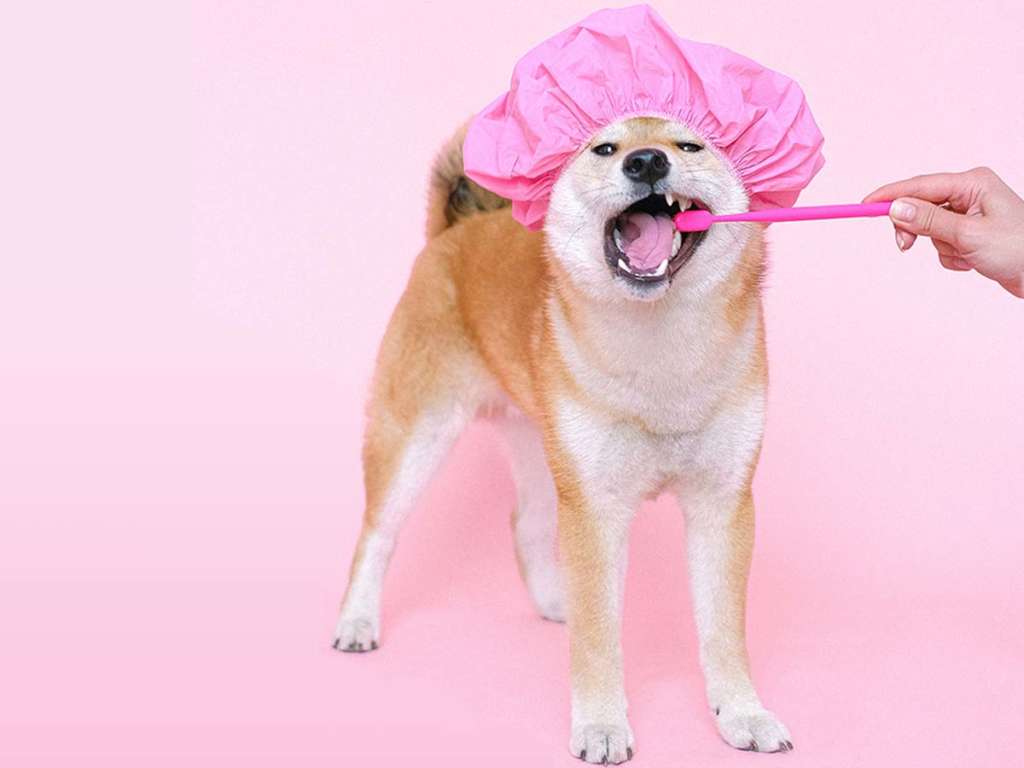

Brushing your dog’s teeth is the gold standard in doggie preventative dental care. Studies have shown that brushing your dog’s teeth consistently—preferably once per day—is the most effective way to help prevent periodontal disease2. Strong and healthy teeth can help enhance your dog’s abilities to conduct professional toy-fluffectomies for many years to come. This is great news for your pup. (Maybe less great news for your wallet as you refresh their inventory of plush toys!)
- What’s The Best Toothbrush To Use For Your Dog? – Studies have shown that toothbrushes with a backward tilting angle at the neck perform best for dogs3. However, ordinary human toothbrushes will work just fine (plus, where are you going to find a dog toothbrush with characters like Bluey on them?). You can also consider less intimidating alternatives like finger toothbrushes or gauze for dogs who tend to get stressed out over toothbrushing.
- What’s The Best Toothpaste To Use For Your Dog? – The best toothpaste is one specifically made for dogs with a flavor that your dog loves. NEVER use human toothpaste for dogs, as it can contain ingredients that are toxic to dogs, such as fluoride or xylitol (often labeled as birch sugar). Also consider a dog toothpaste that uses an active agent that combats either bacteria, plaque, or calculus/tartar formation (look for products that back up their claims with science or the VOHC seal).
- How Often Should You Brush Your Dog’s Teeth? – Daily is best! Studies have shown that dogs whose teeth are brushed daily have 80% less calculus buildup vs. dogs whose teeth are brushed every other day, who show only 37% less calculus buildup4.
Related Article: How To Brush Your Dog’s Teeth
2. Give Your Dog Dental Chews
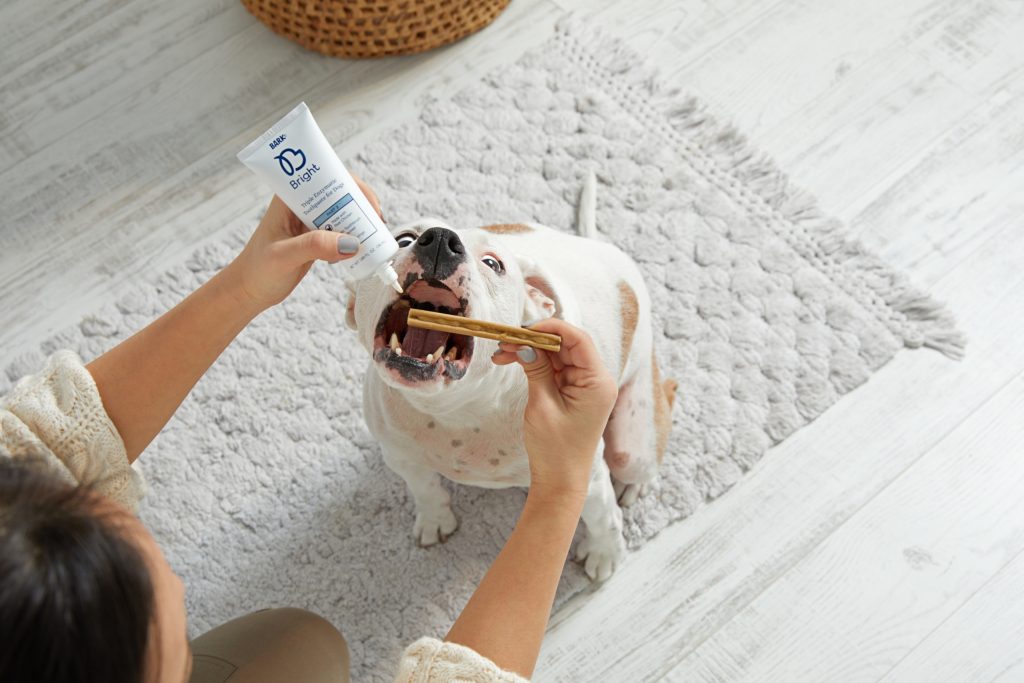

Another fantastic option for helping your dog prevent dental disease are doggie dental chews, like Bark Bright Dental. Although it’s important to keep in mind that not all dental chews are created equal, studies have shown that treating your dog to a daily dental chew is proven to successfully reduce plaque and tartar calculus buildup over time (through abrasion that sort of mimics tooth brushing)5,6, as well as decrease incidents of gum bleeding5,6, improve stinky breath6,7, and overall help prevent future periodontal disease6,8. That’s a win in any pet parents’ book!
- Can Dental Chews Replace Toothbrushing? – Doggie dental chews are best when used as a supplement to toothbrushing—like a tag-team effort to fight plaque buildup, gunky teeth, and funky breath. At the end of the day, nothing is quite as effective at preventing periodontal disease as toothbrushing. However, dental chews have been proven to effectively help prevent dental disease compared to dogs who don’t receive preventative dental care6,8.
- What’s The Best Dental Chew For Dogs? – It’s important to choose a chew that soft enough to dent with your fingernail (harder chews and bones can lead to broken or cracked teeth!). You also want it to be hard enough that it takes a few minutes to chew. Pick a chew that’s VOHC-accepted, and one that’s the right flavor, size, and texture for your pup.
Related Article: Popular Dog Dental Chews: BARK Bright vs. Greenies vs. Dentastix vs. Whimzees
Be sure to check out a kit like Bark Bright Dental, that includes an enzymatic toothpaste along with the chew!
3. Make Sure Your Dog Has Plenty Of Chew Toys
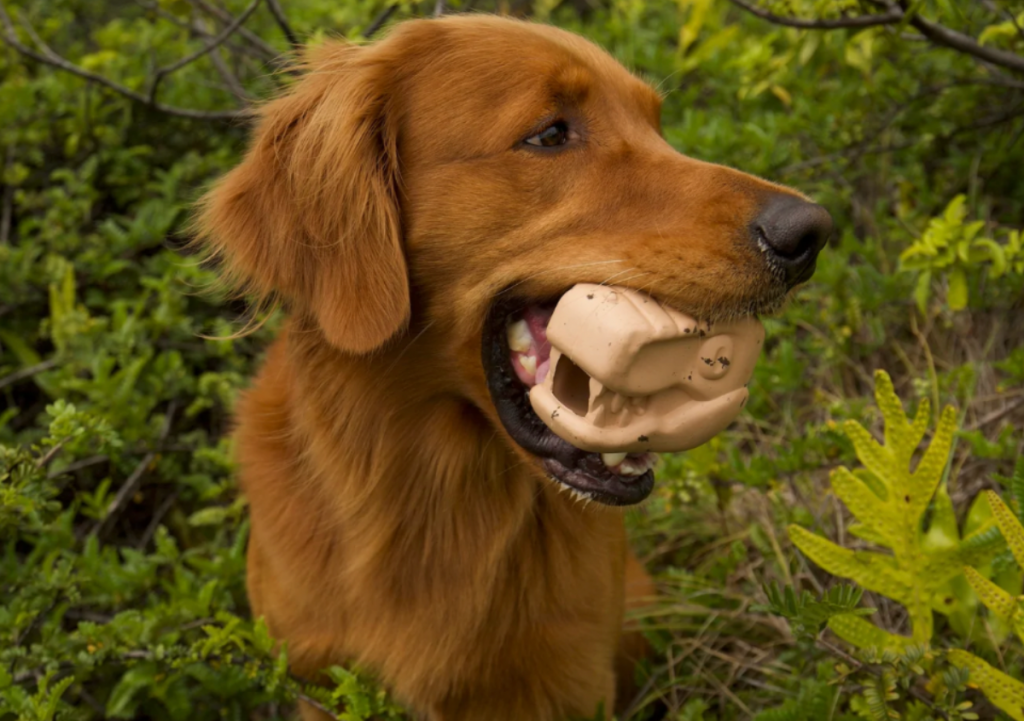

Keeping your dog’s teeth healthy can be fun too! Chewing action can help scrub away leftover food particles and plaque as your dog plays with their toys. Of course, toys alone can’t replace a toothbrush and dental care, but making sure you pup is loaded up with a full stock of chew toys is a great addition to their overall dental care routine.
- What Are The Best Dog Toys For Healthy Teeth? – It’s important to look for chew toys that are firm, yet soft enough that they can be dented with your fingernail. Rubber toys are a good choice. Avoid giving your dog anything harder, like deer antlers and nylon toys. Toys that are too hard can end up doing more harm than good by leading to cracked and broken teeth9. For an added bonus, look for some toys with texture that can help scrub as they chew. Remember to always supervise toy time – ingesting toys can cause lots of non-dental-but-also-very-serious problems for your pup.
Related Article: Help Keep Your Dog’s Teeth Clean With Super Chewer’s “Sharks” Collection
4. Try Additives For Their Water
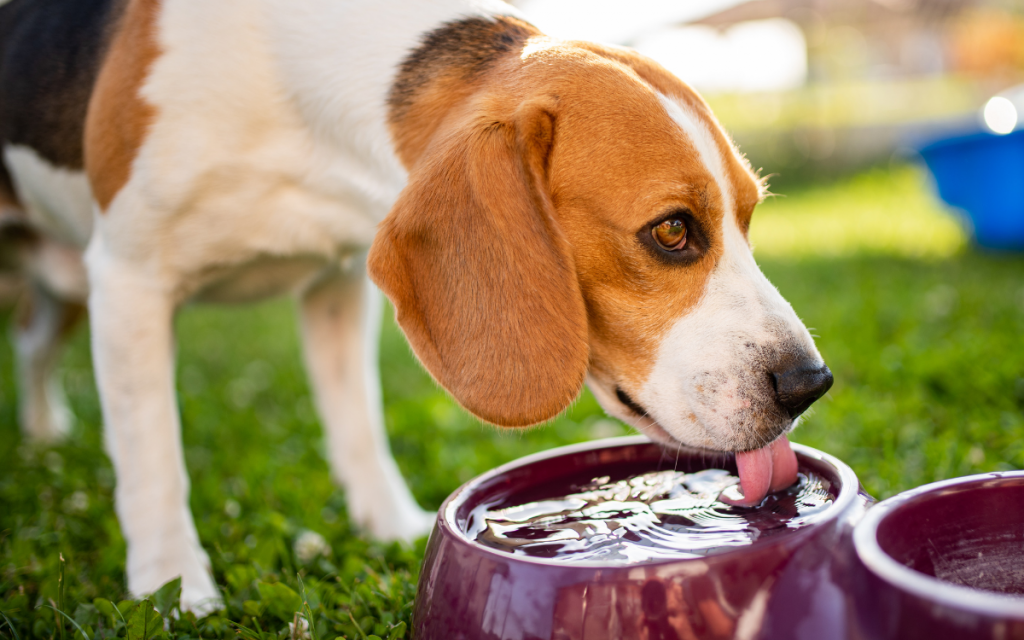

Water additives can be another helpful addition to use in conjunction with your dog’s overall dental routine. Make sure to look for water additives that have been VOHC-approved to reduce plaque and tartar. This way you know you’re choosing a product that’s been tested and has proven results, and isn’t just a gimmicky waste of money. Always avoid water additives that use xylitol (sometimes labeled as birch sugar) in the ingredients, as this toxic to dogs9.
- How Do Water Additives Work? – Many water additives use enzymes to reduce the buildup of salivary glycoproteins—the stuff in your dog’s drool that builds up on their teeth, creating a party environment for nasty bacteria. Other additives often include zinc, which also helps fight off those nasty mouth bacteria9.
5. Doggie Dental Rinses, Gels, And Sprays
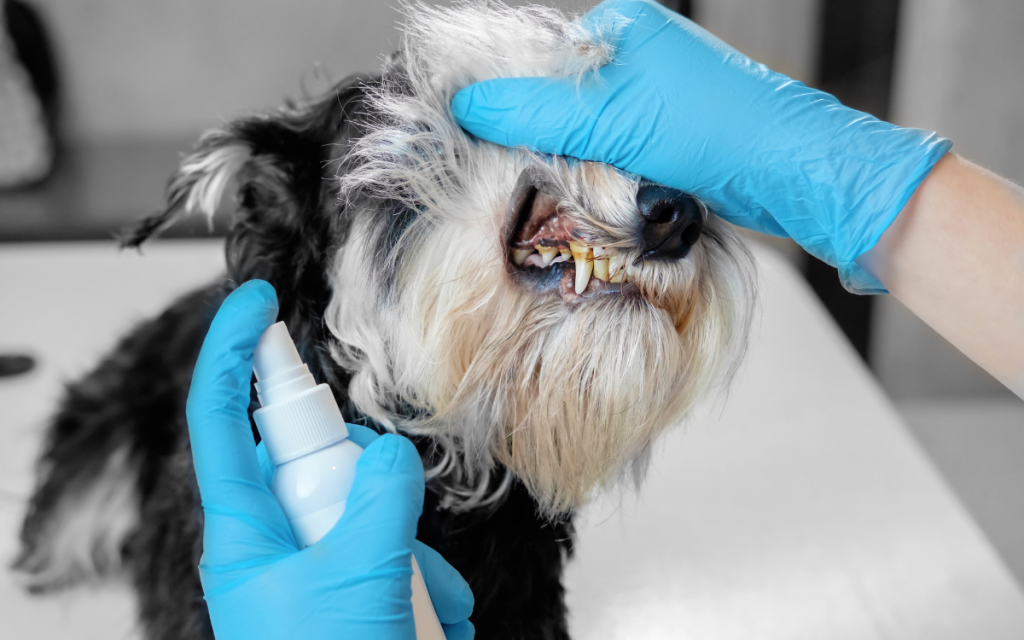

There are a ton of doggie dental rinses, gels, and sprays on the market to help your pup prevent dental disease, and give them that oh-so-smoochable fresh breath. These products use ingredients that work to fight the bacteria that leads to plaque buildup, and kills those nasty germs that make their breath reek.
- Which Doggie Dental Rinse, Gel, Or Spray Is Best For Your Dog? – First, look for one that has the VOHC seal of approval for plaque and tartar control, so you know it’s been proven effective. Next, choose an option with a flavor your dog will love, and one that’s easiest for you to apply without fuss.
6. Dog Dental Wipes
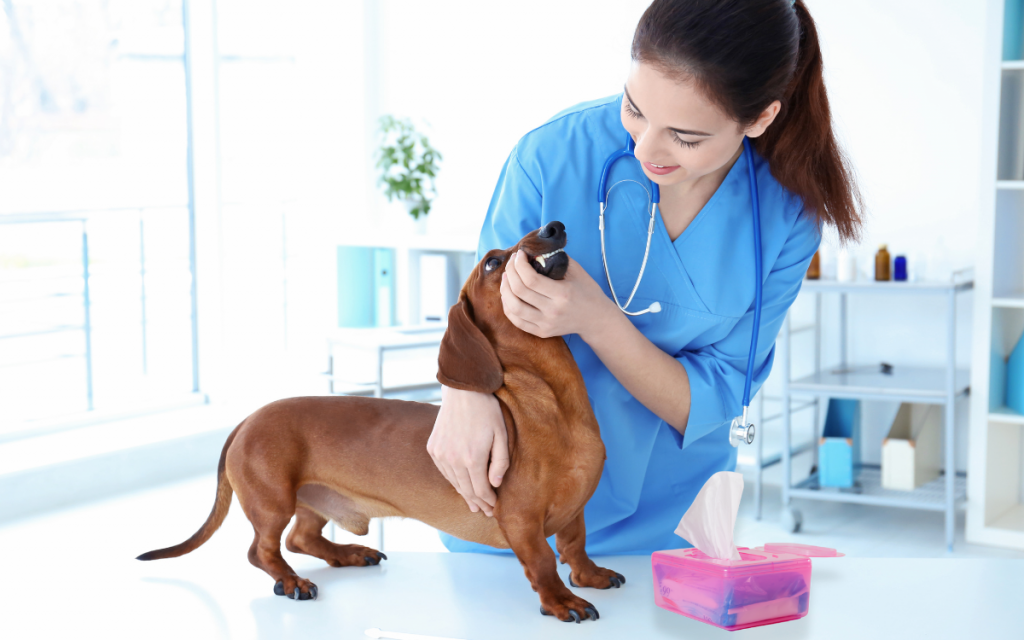

Doggie dental wipes—an often overlooked option—are a great mess-free addition to your dog’s clean-teeth routine. Many doggie dental wipes have anti-microbial properties (helps kill germs), while others contain ingredients that help prevent plaque and calculus buildup9.
DO NOT confuse doggie dental wipes with products like Lysol and Clorox wipes—they are not the same and are not interchangeable! NEVER use wipes made for humans on your dog, as they often contain ingredients that are toxic to your pup. Doggie dental wipes are specifically made with dog-safe ingredients targeted toward dental care. Here’s a quick look at popular doggie dental wipe ingredients and how they work:
- Chlorhexidine – This ingredient has antiseptic properties (a.k.a helps fight bacteria and other microbes), and has been shown to reduce plaque buildup9.
- Zinc – You’re likely more familiar with zinc than the others in this list, but you might not know that zinc plays a role in preventing plaque and tartar buildup by fighting nasty bacteria in your pup’s mouth.
- Sodium Hexametaphosphate9 – Yea, that’s a mouthful! This fancy-pants ingredient helps limit the availability of minerals like calcium in the saliva, which are essential for transforming soft easy-to-remove plaque into cement-like calculus on the tooth. This makes the gunk on the tooth easier to brush away! It can also reduce staining of the tooth enamel through a similar mechanism.
7. Dental Diets And Treats
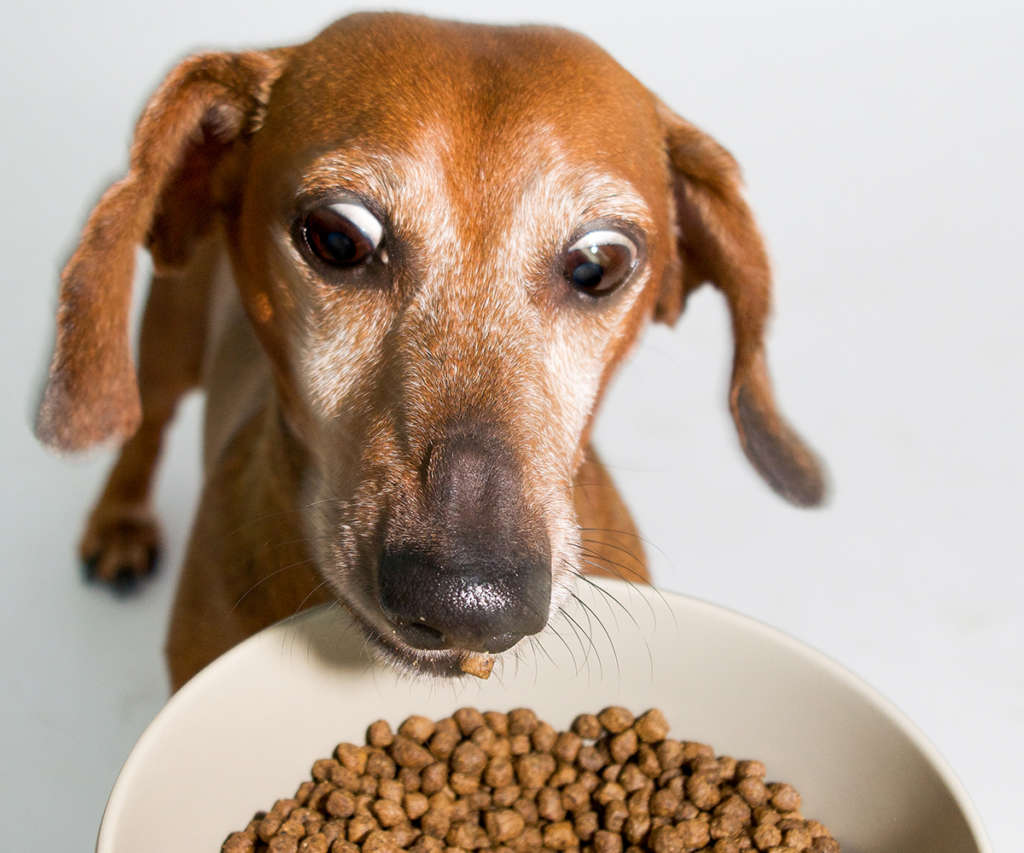

Let your dog munch and crunch their way toward healthier teeth! When combined with a dental care routine, dental diets can make a huge difference in your pup’s oral health. These diets use a combination of increased fiber, larger kibble size, and a patterned texture to help control plaque and calculus buildup. Some of these diets also use a special coating on the kibble that claims to reduce plaque buildup, but there still seems to be some debate about how effective these coatings are9,10. It’s important to always talk to your veterinarian before changing your dog’s diet.
- How To Choose A Dental Diet – Look for dog food with labels such as “dental care” or “oral health” that have a VOHC seal of approval for calculus control or plaque and tartar control. Keep in mind that most dental diets require a prescription from your dog’s veterinarian.
- What To Consider Before Choosing A Dental Diet – It’s important to consider if a dental diet will benefit your dog. Larger dogs who tend to inhale their food without chewing might not see much improvement from a dental diet. Smaller breeds who tend to be picky and avoid larger, crunchy foods may snub their nose at dental diets that take more effort to chew. Lastly, if your dog has additional health problems that take priority, they may need to stick to other specialized diets.
- Are Raw Diets That Include Animal Bones Beneficial? In recent years many pet parents have been turning to raw food diets in an effort to improve their dog’s health. These diets sometimes include animal bones. However, there is no scientific evidence that raw diets are beneficial for dental health (and yes, there have been several studies). Not only that, but pet parents should be aware that diets including bones can lead to cracked or broken teeth, could introduce harmful bacteria from the raw meat (even if your dog doesn’t get sick, it exposes all the humans in the house as well – a big problem for babies and elderly people in particular), and can create a choking hazard9.
Looking for a proactive approach to your dog’s dental health? BARK Bright pairs an enzymatic toothpaste with specially-shaped dental chews so your dog’s pearly whites stay in tip-top shape!


8. Dental Health Supplements
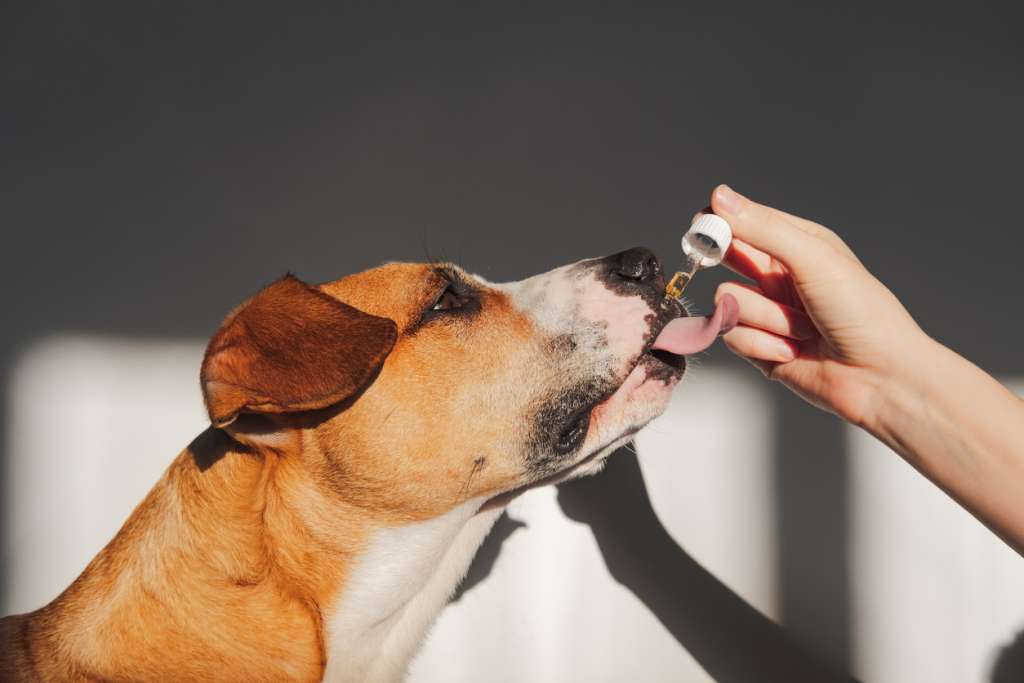

Doggie dental health supplements come in many different forms, including supplemental chews, liquid drops, food toppers, and even powders. Some dogs may prefer supplemental powders hidden in their food, while others may like chews that make them think they’re getting a treat. Look for a VOHC-approved supplement that your pup loves, and talk to your vet about supplement ingredient options that will work best for you dog.
Probiotic Dental Supplements – Probiotic supplements help to restore the balance of good bacteria in your dog’s mouth—promoting healthy teeth and fresher breath.
Dental Supplements With Enzymes – The enzymes in these supplements, along with other ingredients, help to break down leftover food and gunk that can get trapped in between your pup’s teeth.
Vitamin, Mineral, And Superfood-Based Supplements – These supplements include ingredients such as calcium, zinc, vitamin A, folic acid, and kelp/seaweed, among others, to help support oral health by reducing gum inflammation and plaque buildup.
This article has been reviewed by Margo Hennet, DVM.
Margo Hennet, DVM, cVMA, and veterinarian at BARK is a canine nutrition, health, & wellness connoisseur. She has a combined 10 years of experience in clinical medicine, research, and education—that’s 70 dog years of know-how—and graduated from Colorado State University as a Doctor of Veterinary Medicine. She completed specialized training in internal medicine prior to working as a general practitioner in Colorado, has authored peer-reviewed publications and textbook chapters, holds certification in veterinary medical acupuncture, and is a member of the American Academy of Veterinary Nutrition and American Veterinary Medical Association.
Sources:
1 Niemiec, Brook A. “Periodontal Disease.” Science Direct, Topics in Companion Animal Medicine, 13 May 2008, https://www.sciencedirect.com/science/article/abs/pii/S1938973608000056.
2 Allan, R. M.; et al. “Prospective Randomised Blinded Clinical Trial Assessing Effectiveness of Three Dental Plaque Control Methods in Dogs.” Wiley Online Library, Journal Of Small Animal Practice, 21 Dec. 2018, https://onlinelibrary.wiley.com/doi/abs/10.1111/jsap.12964.
3 Huang, Yu Shu, and Cheng Qi Xue. “Research on the Ergonomic Design of Pet Dog Toothbrush Neck.” E3S Web of Conferences, EDP Sciences, 21 June 2021, https://www.e3s-conferences.org/articles/e3sconf/abs/2021/51/e3sconf_eilcd2021_03038/e3sconf_eilcd2021_03038.html
4 Hietakangas, Mirella. “Homecare in Prevention of Periodontal Disease in Dogs and Cats: Owner Awareness and Attitudes.” DSpace, Eesti Maaülikool, 31 May 2019, https://dspace.emu.ee/handle/10492/4911/.
5 Gawor, Jerzy. et al. “Comparison of a Vegetable-Based Dental Chew to 2 Other Chews for Oral Health Prevention.” Sage Journals, Journal of Veterinary Dentistry, 16 Nov. 2021, https://journals.sagepub.com/doi/full/10.1177/08987564211054225.
6 Quest, Bradley W. “Oral Health Benefits of a Daily Dental Chew in Dogs.” Sage Journals, Journal of Veterinary Dentistry, 1 June 2013, https://journals.sagepub.com/doi/abs/10.1177/089875641303000203.
7 Carroll, Meredith Q.; et al. Effects of Novel Dental Chews on Oral Health Outcomes and Halitosis in Adult Dogs, Journal of Animal Science, Volume 98, Issue 9, September 2020, skaa274, https://doi.org/10.1093/jas/skaa274
8 Brown, Wendy Y.; et al. “Effective Periodontal Disease Control Using Dental Hygiene Chews.” Sage Journals, Journal of Veterinary Dentistry, 1 Mar. 2005, https://journals.sagepub.com/doi/abs/10.1177/089875640502200102.
9 Harrison, Claire. “Nutrition and Preventative Oral Healthcare Treatments for Canine and and Feline Patients.” MAG Online Library, The Veterinary Nurse, 2 Oct. 2017, https://www.magonlinelibrary.com/doi/abs/10.12968/vetn.2017.8.8.432.
10 Hennet, P. “Effect of Pellet Food Size and Polyphosphates in Preventing Calculus Accumulation in Dogs.” Journal of Veterinary Dentistry, U.S. National Library of Medicine, 24 Dec. 2007, https://pubmed.ncbi.nlm.nih.gov/18309857/.

